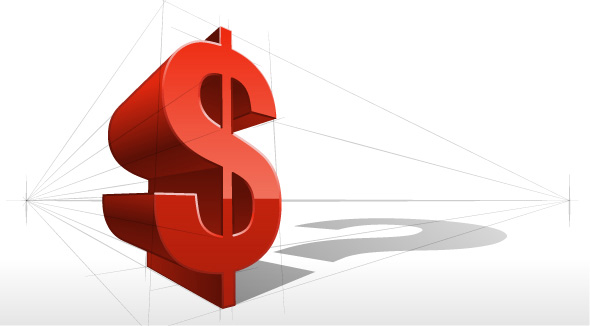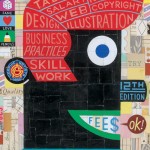
When freelancing as a technical illustrator, deciding what to charge clients can be as delicate and precise an art as technical illustration itself.
Here are three key factors to consider when quoting on a project:
- How much of my time & resources will the project take, and what is that worth?
- What is the ‘going rate’? What do other illustrators charge?
- What will the market bear?
How much of my time & resources will the project take?
The specifics of the project (the specs) greatly affect how much work is involved, and how long it’d going to take to complete. Consider size (1″ sticker or Sistine Chapel?), complexity of the subject matter (Newton’s Cradle or Large Hadron Collider?), the quality of the reference materials (orthographic plans, low-res cell phone pics or high-res on-angle photos?), rendering style (line drawing or fully-rendered airbrush?), turnaround time (months or days?).
A short turnaround might mean you have to pull an all-nighter or postpone other work. Low quality reference materials might make the work much more difficult than a project with proper reference that gives you all the information you need. Either of these situations could make the work twice as hard. Both of them together could make it exponentially harder. Consider this when estimating your time.
One of my instructors in college had this advice: “Think of how much time you think it will take you to do the work. Double it. Don’t think about it, just double it. You’re not as fast as you think you are, going back and forth with the client takes time, and if something blows up in your face, you’ll have time to fix it.” This was great advice for me when I first started freelancing.
Since then, I’ve religiously timed all of my projects using a simple dashboard widget and created a spreadsheet record of how long different projects took me. This way, I can quote on new jobs based on my actual performance on previous jobs.
What are my time & resources worth?
This one’s easier: use the FreelanceSwitch Hourly Rate Calculator. Multiply this hourly rate by your estimate of how long the project will take to get your fee.
A freelancer’s hourly rate should be double that of a full time employee doing the same job — freelancers pay for their own equipment, furniture, rent, utilities, payroll deductions, health insurance, vacation time, retirement fund, etc.
If you’re really busy, not that interested in the job, or know the client to be finicky, it’s fine to put your price up. If you really want the job, or are desperate for work, then offer a lower price or a one-time discount (be strategic about this or clients will expect a discount). Your time is subject to supply & demand as much as any other commodity.
In my experience, most clients prefer a flat rate, rather than an hourly rate – one price for the entire project. Be very detailed when outlining the project in your quote or you’ll find yourself chasing a moving target at your own expense. Specify a limited number of changes and develop a client approval process that prevents surprises for either party. Leave some padding.
UPDATE: The FreelanceSwitch calculator is down. Try out our own Freelance Hourly Rate Calculator!
What’s the going rate?
The client has probably requested quotes from other illustrators as well as you, and your price will compete with theirs. Do you want price to be your competitive advantage? Probably not: the client has shortlisted you based on your portfolio, not your price. Besides, a common practice is to throw out the highest and lowest quotes, and pick from the middle.
But what is the middle?
The Graphic Artists Guild Handbook: Pricing and Ethical Guidelines is a good place to find out. It’s a published survey of thousands of professionals regarding trade practices and typical fees for specific services.
For example, for a full page technical illustration for an advertisement in a single-interest or small circulation magazine (such as Scientific American or Golf Digest), the surveyed illustrators reported fees between $1,500-$2,700 USD.
That doesn’t mean your price should be in that range. It may be higher or lower, depending on the project’s specs, how much time it’ll take you, how much you want the project and how much you want to make, and how much the client is prepared to spend.
What will the market bear?
Why charge a big client more than a small client for the same work? The work is worth more to a big client. A multinational consumer product manufacturer can print your instructional illustration and ship it with thousands or millions of units in numerous languages, create online client education portals, instructional videos, etc. Without getting into copyright in this post, the big client gets more value from the same work.
Big clients also mean more people at the table, more decision makers. Budget for a few conference calls, crossed lines, contradictory emails and delays getting approvals.
In economically uncertain times, businesses can be hesitant to spend. They’re looking for the best value for their money. That doesn’t change how much work is involved for you, or how much you should charge, just something to be aware of. Look for ways of building more value into the project and give your contacts good service.
If you’re not sure how much the client is willing to spend, it doesn’t hurt to ask. Explain that you can tailor your style and techniques to whatever budget they’ve committed to the project. It won’t work all the time, but when it does, everyone gets what they want.
The bottom line
Your fees should be based on something. If they don’t make sense to you, how are they going to make sense to the client? You can’t win every proposal, but if your prices take into account your needs, the client’s needs, and industry standards, you’ll feel more confident when sending out quotes and satisfied when sending out invoices.
Not everyone is comfortable discussing their income. But as a profession, it’s important to have some open discourse about the factors influencing what we take home. What factors affect your pricing? Sound off in the comments!


Good info on an ever challenging topic. I find it important to include language in the proposal that addresses changes in scope of the agreed upon project requirements. Sometimes tricky to append an estimate but at least you have some justification in writing.
That’s very true, the terms and conditions are just as important as pricing the project.
Probably worth doing another post to explain what the common t&cs mean since the language can be so esoteric!
Great advice about doubling the time you think it will take. There are usually aspects of a job that are hard to figure time-wise. The illustration time is often only a large fraction of the total time spent on a job. And then a round of changes when the client actually sees the work…
Congratulations on a well done and helpful newsletter-website.
Mike
Excellent post.
I find it best when the client tells me the budget for the project at the beginning. It gets rid of the stress of trying to strike a balance with your quote between not coming off as too expensive (looking like you’ve got higher expectations than the market can offer) and quoting a low fee (looking like you don’t value your own work).
That book you mentioned: The Graphic Artists Guild Handbook, has actually been a huge help over the years in not only coming up with prices, but other aspects of freelancing as well: preparing estimates, invoices, other contracts, dealing with conflicts, etc.
Davvi
Excellent advice. Is there any opportunities for an
old-fashion pen and ink-templates and triangles
illustrator with more than 25 years experience ?
Please advise.